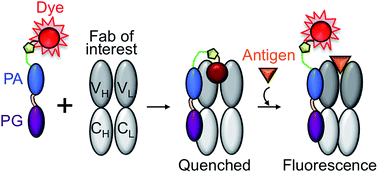One-pot construction of Quenchbodies using antibody-binding proteins†
Abstract
Fluorolabeled antibody-binding proteins were constructed based on Staphylococcus protein A and Streptococcus protein G domains, and used as an adaptor to convert the Fab fragment of interest to a Q-body, a fluorescent biosensor that exhibits antigen-dependent fluorescence enhancement. Without having to perform the tedious procedure of genetically introducing a fluorescent dye molecule into a cloned Fab fragment, we successfully converted both a cloned anti-osteocalcin Fab fragment and a commercially available anti-vimentin (Fab)2 fragment to a Q-body using this method. This method is not only a simpler way for constructing Q-bodies but also a convenient alternative to finding a suitable antibody that has a greater potential to become an excellent biosensor.



 Please wait while we load your content...
Please wait while we load your content...